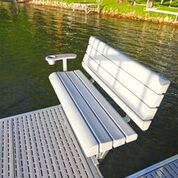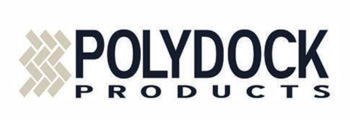Jul 7, 2020
Do I need a new dock?
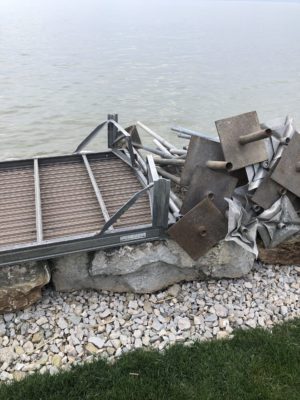
Do I NEED A NEW DOCK?
Docks that are several years old will show some signs of wear. It might be the decking, or it could be the frames. Either way, your dock needs yearly inspections. It’s especially true this year.
Why? You guessed it – the storms. At least two things are happening. Record-setting water levels mean the waves can dislodge trees, logs, and other floating objects that have been sitting dormant on the shore for years. They get washed along the beaches and could hit your dock or boat lift during a storm.
Other docks or decking from your neighbors’ pier can be washed out too. That debris could also hit your dock. Don’t forget about the jet skis and boats that get dislodged in the significant storms.
How many times does it take to cause damage to a dock or boat lift?

Dock damage
Once could be enough. Imagine a boat or log floating under your dock or into your boat lift. The next wave pushes it up against the bottom of your dock or lift. With the wood hung up under the frames, they get twisted by the waves. Here’s the result.
Is the hardware still holding tight?
At one point, at least one manufacturer’s decking was glued and stapled. This decking did not have enough support under the decking, either. The constant flexing of the panels and the natural wood shrinkage meant the staples loosened, and the glue let go.
Consider replacing a wooden decked pier with a different material. If the frames are sound, you may be able to use the Flow-through decking options.
Flow-Through decking is considered the best decking available. For more information, click HERE.
What about the frames?
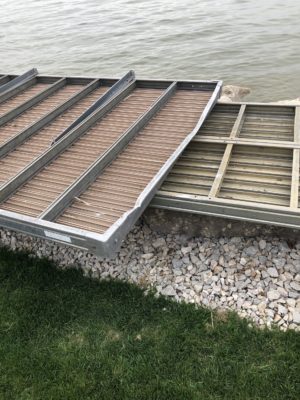
Is your dock frame bent?
How much wear and tear is the question. Proper maintenance of a dock system can help keep it looking beautiful for a long time. Some types of damage are easily repaired. Others need a lot of work.
But, if your dock is getting dangerous and unreliable, replacement might be the best option. Here are some more signs that you should think about investing in a brand new dock.
Widespread Rust
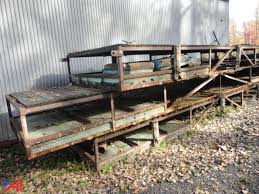
Do I need a new dock?
Certain types of metal used around water will rust. Painted, and even powder-coated metals will need regular upkeep to keep ahead of the rust.
Large areas of rust will spread. They eat away at the dock frames. If the metal rusts through, it can cause breakage in other areas too.
In cases like this, a completely new dock might be necessary.
Aluminum docks are made of rustproof metal and are a great option when considering upgrading or replacing a failing dock.
Have wood – will rot, Discolor, Split … You get the point!
Wooden docks can rot when water seeps into the wood. Moss, mildew, algae, and other growth can trap moisture in the wood decking, worsening the situation. However, it can be solved or prevented by keeping your dock clean and well maintained.
If a small area is experiencing rot, replace the individual components with new, treated lumber. But, when multiple areas are rotting, it’s time to replace your dock.
Consider replacing a wooden pier with different materials, including aluminum painted to look like wood, which is one of the premium ShoreMaster decking options.
Cracked or Warping Dock Supports
Has any boat come in “hot” (too fast) and hit the frames or vertical supports? Maybe a wave pushed your boat faster than expected or in the wrong direction. Accidents happen!
While the damage may appear only superficial, it’s essential to check all the welds in the immediate area.
Don’t let this type of damage go unattended. With the current rash of storms and high water, this type of damage can quickly become critical.
Minor cracks in small areas may require welding or the replacement of some parts. If major load-bearing areas have significant damage, it’s better to stay safe and replace the structure.
Can a permanent dock be damaged?
Permanent docks sit on large pipes or underdeck support systems. Assessing the damage below the waterline, let alone repairing it, requires specialized equipment.
Dock foundations are subject to:
- Water movement,
- Changing temperatures,
- Currents,
- Ice movement, and
- Other factors that can cause foundation shifts and severe damage.
Cracking is a sign that further investigation and possibly replacement of your docking system will be needed.
Posts Can’t Be Set Properly?
Permanent boat docking systems have supports to hold them up. In some instances, the support pipes must be driven up to 100 feet deep at times to find the solid rock. Even then, winter ice can grip the outside of the post and raise it again.
If the ice raises your posts, it might be time to replace your dock. Look into a floating aluminum or steel dock that adapts to fluctuating water conditions. This type of dock can be removed in winter or protected by a “de-icer” system. The “de-icer” system prevents the ice from locking onto the pipes and being drawn back up.
Custom Docking Systems – Pier & Waterfront Solutions
If it’s time to replace or upgrade your boat docking system, PWS can help. We are the experts in the waterfront business. We have helped many shoreline owners find their perfect waterfront solution – it’s written right into our name.
Did you know PWS has new and used aluminum or steel docks and lifts available? We also have the New 3-Season Pier (steel) for the roughest of waters.
Need an entirely new aluminum dock system or the perfect accessory? Pier & Waterfront Solutions has a support team that can help.
Remember, Pier & Waterfront Solutions (PWS) specializes in Waterfront Solutions for docks and lifts.
For more information and what works best for your area, contact Jerry @ (920) 493-4404 TODAY – or – fill out this simple quote request form.
Where is Pier & Waterfront Solutions?
Located at 7325 St. Hwy 57, it’s 3 miles south of Sturgeon Bay, and 1 mile past the intersection of Cty MM (heading north). Look on the right side, one mile north, at the next intersection (Idlewild Road and Hwy 57).
ARE WE OPEN?
During this time of uncertainty, Pier & Waterfront Solutions has stayed “open.” We have implemented measures to ensure the safety of our employees and visitors. At the same time, we are working to maintain the trusted service that you have come to expect.
We are conducting as much business as possible by email, text, or phone. Site visits will continue as usual. When in-person contacts are necessary, we will follow “social distancing” guidelines.
Our display yard is always open for you to examine at your leisure. All displays have a numbered, red tag on them. If you want more information or pricing, please reference that number.
We provide estimates and invoices by email to make the process paperless and faster. With these measures, we hope everyone will stay safe, and we will be back to normal operations soon.
What can YOU do to help us?
Please conduct as much business as possible via emails, messaging, and emails. When you see our crews installing equipment, please practice “social distancing.”
Please call, message, or email us with any questions.
Thank you for allowing us to work with you.
Let’s all stay safe!
Jun 16, 2020
A Boat Lift Safety Lesson
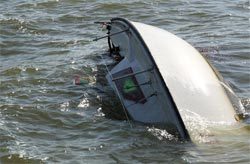
My lift cable broke…and I can’t ….
Proper boat lift safety means you won’t have to learn the tough lesson pictured here. If you apply these recommendations, you can relax and enjoy your boating experience.
Failure to follow these safety suggestions may result in damage to your boat or even personal injury.
Boat Lift Safety = Never exceeding the Ratings
The rated capacity of any lift is the maximum capacity, and you should never exceed that amount.
Boat weight INCLUDES more than just the published weight of the boat. It also includes the weight of fuel, water, and equipment. After all, you will be lifting all of this when you raise your boat. It adds up very quickly!
Plus, we recommend that you allow at least a 300-500# margin of error when you calculate the boat weight. See also: Sizing a Boatlifts: How to select the correct Boat Lift.
If you ever hear a salesperson say, “You can easily go 40% or 50% over that rating without a problem”. You are at risk of being the owner of the boat above if you follow that flawed thinking.
What’s the real story?
Lift cables are rated much higher than the rating of the boat lift. As an example, (using imaginary numbers) your boat lift has a 4,000# rating, it could have cables rated for 6,000# to 8,000#.
The cable rating may be 6,000#, but ONLY if the wires are in perfect shape – meaning no burrs, kinks, frays, or rust. These defects reduce the load capacity of the cables.
The lift racks are correctly rated for the weight regardless of the cable ratings. If someone is trying to sell you a 4,000# lift and telling you that it can handle up to 4,700# – WALK AWAY!!
The load must also be “balanced” on the rack for proper boat lift safety. (More on this later)
Lift cables fail without warning
Sorry!! Cables don’t “creak” or “groan” as a warning of impending danger. The only sound you hear is a loud “snap” followed by the sound of your boat hitting the water.
In a storm, you want to get your boat as high above the water as possible. Yet, raising a boat until the lifting platform or rack hits the frame is NOT the way to do it.
Hitting the frame is an all too common occurrence. Ask yourself, if raising the boat that extra ½” is worth snapping a cable. You risk damage to your boat and lift, or worse yet, personal injury.
Operate Lift Motors properly or break a cable
Properly used, an electric lift motor is a real back saver! I wouldn’t be without one. But you need to exercise extra care when using a lift motor. Shutting off a lift motor does not mean the lifting action will stop. What if it “drifts”?
For example, one brand of lift motor “drifts” after the motor stops. The “drift” potentially causes the lift rack and frame to jam together.
Cable failure, lift or boat damage, personal injury, or worse may be the result.
When the rack hits the lift frame, something has to give. The most likely culprit will be the cables. If you combine a damaged cable with a rack hitting the frame, you have a recipe for disaster.
OK, You Jammed the Rack & Frame! – What comes next?
You were distracted, and now the rack is jammed against the frame. A jammed rack means your next step is critical.
You’re in a hurry to release the pressure, but be sure you know which way the motor will go when you flip the switch.
If the rack isn’t going “DOWN,” damage occurs almost instantly. If it is a broken cable – your boat goes down – even faster!! Starting the winch or motor in the wrong direction could mean your boat will be in the water in an instant. Did I mention it won’t be floating?
Proper Positioning of the boat is part of boat lift safety.
As if a jammed rack wasn’t enough, did you know there are right ways and wrong ways to position your boat on your lift?
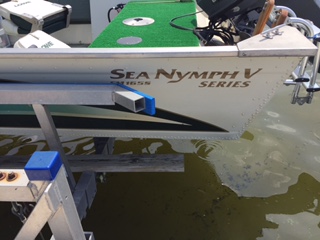
Boat stern overhanging too far
All lift ratings are based on a “balanced load.” In other words, the weight of the boat must be relatively equal on each end of the rack.
When you put the majority of the weight on one end of the rack, cable breakage is more likely.
The heaviest part of any boat will be where the engine is mounted. That could be at the stern (outboards) or even near the middle of the boat (inboards).
A boat placed too far forward on the lift rack results in excessive weight on the “front” of the lift. Too far to the stern of the boat puts too much weight on the rear cables. If the cables have weakened by corrosion or fraying, you risk impending disaster.
What is the correct position for a boat on a lift?
You can determine the proper positioning of a boat by placing the stern of the boat within 12″ – 18″ of the rear lift rack. Now, raise the rack slightly out of the water.
Next, try to lift the bow end with your hands. If the boat weighs 3,500# and you can lift the front of the boat, you are either “Mr. Atlas” or the boat is positioned to the rear. If you can lift the bow at all, your boat is too far back. The weight is not evenly distributed across the four corners of the lift. Lower the boat and reposition it forward.
The boat shown here overhangs about 36″ from the rack and risking major damage. By placing the boat too far back on the rack, a majority of the weight is on the rear cables. What if those cables are weak from corrosion or fraying?
Does high water affect the positioning of a boat?
Yes, it does. In the example above, with the rear of the rack overloaded, the boat has only minimal weight on the front rack.
Your boat will float on a wave. When the bottom of the boat is “lapped” by a wave, it will try to raise the boat. With repeated lifting (or bouncing) the boat can work it’s way off the rack. It will try to go go to the rear. Eventually, the boat will literally “bounce” right off the lift.
With a balanced boat, you have a better chance of the boat staying on the rack.
Align the boat in the same position each time.
So, now you have repositioned your boat until you found a good position for a balanced load. What comes next?
It’s time to make a note of a fixed object on the boat and how it lines up with something on the lift. This is a good gauge for the next time you enter your lift. Always try to go back to this same position.
Summary
You now know the do’s and don’t of boat lift ratings and positioning for your boat. With this knowledge, you can Relax and Enjoy your boating experience.
Where is Pier & Waterfront Solutions?
Located at 7325 St. Hwy 57, it’s 3 miles south of Sturgeon Bay, and 1 mile past the intersection of Cty MM (heading north). Look on the right side, one mile north, at the next intersection (Idlewild Road and Hwy 57).
ARE WE OPEN?
During this time of uncertainty, Pier & Waterfront Solutions is staying “open.” We have implemented measures to ensure the safety of our employees and visitors. At the same time, we are working to maintain the trusted service that you have come to expect.
We are implementing these precautionary measures:
1. Conducting as much business as possible by email, text, or phone.
2. Site visits will continue but with limited in-person meetings. When in-person contacts are necessary, we will follow “social distancing” guidelines.
3. Our display yard is always open for you to examine at your leisure. All displays have a numbered, red tag on them. If you want more information or pricing, please reference that number.
That’s not all!
4. Some employees are working remotely, but they are always available by phone.
5. Any employee exhibiting symptoms or illness is sent home.
6. We provide estimates and invoices by email to make the process paperless and faster.
7. Crew starting times are being staggered to limit social interactions.
8. We keep the same crews together to limit cross interactions.
With these measures, we hope everyone will stay safe, and we will be back to normal operations soon.
What can YOU do to help us?
1. Please conduct as much business as possible via emails, messaging, and emails. This step protects everyone involved.
2. When you see our crews installing equipment, please practice “social distancing.”
So, YES – WE ARE OPEN!
Please call, message, or email us with any questions.
Thank you for allowing us to work with you.
Let’s all stay safe!
Contact:
Jerry @ (920) 493-4404 or Jerry@wisconsinpws.com – Commercial work & new/used Sales.
Dave @ (920) 905-2588 or Dave@wisconsinpws.com – Erosion control & shoreline work.
Jerry @ (920) 493-4404 or Jerry@wisconsinpws.com – Scheduling & Service work
May 19, 2020
The Best Boat Dock Decking in Door County
Boat dock decking is no longer a simple piece of wood laid on other pieces of wood. There are many types of materials used on piers and boat docks today.
Today’s options include open-deck plastic, solid plastic boards, aluminum, wood, and various composites.
What’s the most popular decking used today, and why?
Today, wise shoppers choose plastic with the open-deck configuration.
Why?
It’s simple. The best type of decking is a plastic deck. Today’s plastic holds it’s original color (within 3%). It also keeps it’s shape better. Plastics need less maintenance than any of the other types of decking.
Plastic decking requires no staining or painting. The surface does not flake or wear-off, nor does it lose its color with exposure to the UV rays.
Open-decking helps resist the growth of mold and mildew far better than wood or even another plastic deck. Plastic stays cool in the summer, repels rain and dries quickly. About 90% of the moisture runs off immediately while the rest simply evaporates.
What about other types of plastic boat dock decking?
If you are referring to the wood and resin-impregnated boards, over time, the wood fibers swell. The moisture can attract mold and mildew.
How about recycled plastic boards with no fiber in it?
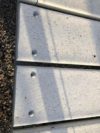
Typical Plank decking
The recycled boards come with their unique problems.
If stored in shaded areas, HDPE plastic boards cannot escape the mold/mildew cycle. See how the mold/mildew cycle develops HERE.
What’s the most important thing about decking?
Recycled decking is an extruded board. That means, when cresting waves hit the bottom of the dock, there is no release for the energy waves produce. The bolted-down boards keep the decking from washing away. But this creates a virtual “solid” surface for the wave’s energy to push against. The frame structure must take all the energy from the wave.
How can you prove this?
Look at a dock that flipped over during a storm. You will notice that the legs bent in the direction that the storm originated.
Solid boards with a 1/2″ gap every 6″ does not relieve the pressure from the waves.
The result is the upward pressure from the waves lifted the pier high enough for it to move sideways. The legs were no longer vertical. They came down at an angle, and the legs bent. The continuing pressure from the waves then pushed the dock over.
Plastic is plastic – isn’t it?
Yes, they are all oil derivatives. But, there are many types of plastic made today. Some are super hard and act as “bearing surfaces,” while others are very pliable.
In general, plastics will outlive us. The shape and surface area of the plastic makes a big difference when it comes to decking.
How do you relieve the upward energy?
The only way to relieve the pressure on the boat dock decking is to provide enough open areas for the wave energy to pass through. 42% open area is the standard today.
At this percentage, almost one-half of the wave energy passes through the decking. The wave is less likely to lift the dock. Yet the decking is strong enough to walk on.
If you combine the most massive steel frame in Door County along with an open deck,
you get the PWS 3-Season Pier.
Don’t Forget – Considering rip-rap for your shoreline? PWS is the place to contact!
Where is Pier & Waterfront Solutions?
Located at 7325 St. Hwy 57, it’s 3 miles south of Sturgeon Bay, and 1 mile past the intersection of Cty MM (heading north). Look on the right side, one mile north, at the next intersection (Idlewild Road and Hwy 57).
ARE WE OPEN?
During this time of uncertainty, Pier & Waterfront Solutions is staying “open.” We have implemented measures to ensure the safety of our employees and visitors. At the same time, we are working to maintain the trusted service that you have come to expect.
We are implementing these precautionary measures:
1. Conducting as much business as possible by email, text, or phone.
2. Site visits will continue but with limited in-person meetings. When in-person contacts are necessary, we will follow “social distancing” guidelines.
3. Our display yard is always open for you to examine at your leisure. All displays have a numbered, red tag on them. If you want more information or pricing, please reference that number.
4. Some employees are working remotely, but they are always available by phone.
5. Any employee exhibiting symptoms or illness is sent home.
6. We continue to provide estimates and invoices by email to make the process paperless and faster.
7. Crew starting times are being staggered to limit social interactions.
8. We keep the same crews together to limit cross interactions.
With these measures, we hope everyone will stay safe, and we will be back to normal operations soon.
What can YOU do to help us?
1. Please conduct as much business as possible via emails, messaging, and emails. This step protects everyone involved.
2. When you see our crews installing equipment, please practice “social distancing.”
So, YES – WE ARE OPEN!
Thank you for allowing us to work with you.
Please call, message, or email us with any questions.
Let’s all stay safe!
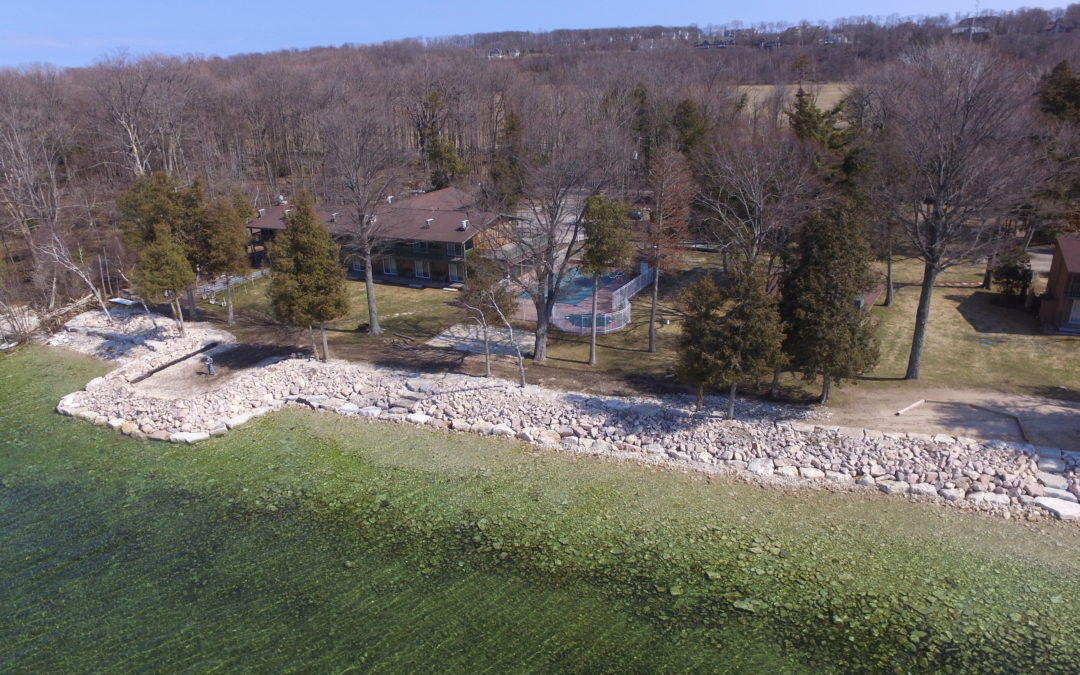
May 5, 2020
Sturgeon Bay business installs Rip-Rap
Pier & Waterfront Solutions has expanded its Sturgeon Bay rip-rap business to handle the increased installation demand on Lake Michigan and the Bay of Green Bay. Installing rip-rap has prevented further destruction due to the high water levels. Pier & Waterfront Solutions has kept its excavators working through the winter to meet the demand.
PWS Co-owner, Dave Kalista, has been coordinating the work for the last two years. Dave recently reported that “As the waters continue to rise, the demand has risen with it. We recently added another excavator to handle the demand.” Dave went on to say, “With the additional excavator, we can better serve our customers in a timely fashion.”
As of Jan. 2020, local waters in Sturgeon Bay and the whole of the Door County Peninsula have risen 39,” year-to-year. 39″ exceeds records set back in 1986. Some experts predict water levels will increase by an additional 20″ by the end of summer.
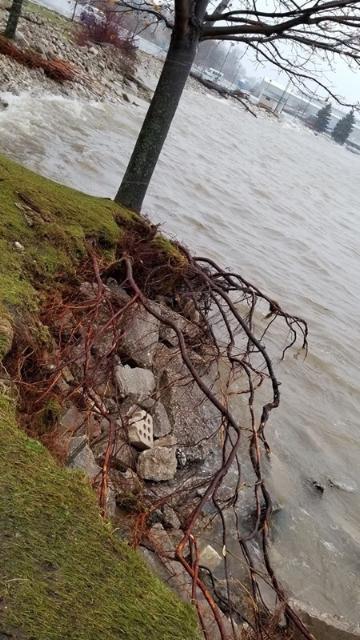
Rip-rap could prevent this.
As a result, beaches are eroding at an alarming rate. The erosion is due to record-setting water levels and intense storms. Typical damage includes eroded beaches, lawns, and uprooted trees and vegetation.
How can you protect your Property?
Experts agree – rip-rap and seawalls are the best methods to protect against erosion. Of the choices, rip-rap is the least costly by far.
Contact Dave at (920) 905-2588 for more information.
Where is Pier & Waterfront Solutions?
Located at 7325 St. Hwy 57, it’s 3 miles south of Sturgeon Bay, and 1 mile past the intersection of Cty MM (heading north). Look on the right side, one mile north, at the next intersection (Idlewild Road and Hwy 57).
ARE WE OPEN?
During this time of uncertainty, Pier & Waterfront Solutions is staying “open.” We have implemented measures to ensure the safety of our employees and visitors. At the same time, we are working to maintain the trusted service that you have come to expect.
We are implementing these precautionary measures:
1. Conducting as much business as possible by email, text, or phone.
2. Site visits will continue but with limited in-person meetings. When in-person contacts are necessary, we will follow “social distancing” guidelines.
3. Our display yard is always open for you to examine at your leisure. All displays have a numbered, red tag on them. If you want more information or pricing, please reference that number.
Is there More?
4. Some employees will be working remotely, but they are always available by phone.
5. Any employee with symptoms or illness is sent home.
6. We continue to provide estimates and invoices by email to make the process paperless.
7. Crew starting times are being staggered to limit social interactions.
8. We keep the same crews together to limit cross interactions.
With these measures, we hope everyone will stay safe, and we will be back to normal operations soon.
What can you do to help us?
1. Please conduct as much business as possible via emails, messaging, and emails. This step protects everyone involved.
2. When you see our crews installing equipment, please practice “social distancing.”
Thank you for allowing us to work with you.
So – YES – ARE WE OPEN?
Please call, message, or email us with any questions.
Let’s all stay safe!
Contact:
Jerry @ (920) 493-4404 or Jerry@wisconsinpws.com – Commercial work & new/used Sales.
Dave @ (920) 905-2588 or Dave@wisconsinpws.com – Erosion control & shoreline work.
John @ (920) 493-4405 or John@wisconsinpws.com – Scheduling & Service work
Apr 24, 2020
The Ultimate Guide to Dock Sway
Define Dock Sway
Dock sway is the side-to-side movement experienced when you walk on dock decking. The higher a dock sits, the more likely it will occur. It can also happen on deeper inland akes, even though the deck is only a foot above the water. Sway is the direct result of the length of the legs and the size of the leg material.
We have published several articles to tell you about the continued rising waters on Green Bay and Lake Michigan.
https://wisconsinpws.com/rip-rap/ &
https://wisconsinpws.com/lake-michigan-water-levels/)
At the time of the most recent report, the water was 14″ higher than last year. Remember, last year was about 12″ higher than the previous year.
Since the most recent update, it has continued to rise several inches more. The upward trend will continue through 2020.
How Much Higher Will the Docks be This Year?
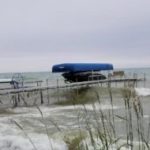
Long legs = dock sway
It will be necessary to raise the docks to adjust for storms. It’s the only way to escape the waves’ energy. The high waves we experience in Door County means it is always prudent to raise the dock accordingly.
What Causes Dock Sway?
The longer the legs are, the more likely you are to experience sway. Let’s look at two examples to explain this:
- A flagpole tends to sway when subjected to strong winds. If you raise the pole 10′ higher without increasing the diameter of the flagpole, you will see much more sway. The higher the pole is, the larger the width of the pole must be.
- If you step on a 6-foot step ladder, the first few rungs are pretty stable. You’re not high off the bottom. The higher you go, the more the ladder tends to sway.
We do not advise this, but if you place your feet on the top rung of the ladder, you need to start looking for a safe place to land.
How Can You Minimize Sway?
There are several things that you can do:
1. Increase the width of the dock. It’s more stable when walking on a wider pier. But, that’s not practical when you already have a dock.
2. The addition of cross-braces on the lower parts of the legs will reduce the swaying motion. Cross braces are rigid pipe(s) attached in an “X” pattern to make the dock stable. Usually, the cross brace attaches near the end of the dock, where the longest legs are used. The end is the most susceptible point on a pier when looking at sway.
3. New this year is the 3-Season Pier. This new pier will also be set high, but the legs are stronger (larger diameter), and the dock is more stable as a result. Cross braces would still be a good idea if your experience sway.
4. Give serious consideration to not installing all the sections you have available. See this article – Shorter Dock on April 28th.
Why Go Through Any of These Expenses?
You could let the waves destroy the dock and get a new one using the insurance money. Wrong!! If you re thinking this way, check out this article along with this article. Insurance will rarely pay for your damaged dock.
What Does the 3-Season Pier Use?
On the 3-Season Pier, we use 2″ schedule 40, galvanized steel pipe, which has an outside diameter of 2 3/8″.
Compare that with the legs used by some competitors, which are 1 ¼” pipe or even 1 ½” tubing. (Tubing is the lightest or thinnest of all the materials used. Tubing is used mainly on all-wood docks). Both of these have little strength, and docks should never use them.
One Last Suggestion
One final recommendation is to use “Flow-Through” decking (see this article on May 19th) This decking minimizes the effects of the waves on the dock. With 42% less deck surface, it allows much of the wave’s energy to pass harmlessly through the decking.
In conclusion
Give serious consideration to not installing the full length of your dock to avoid sway this year.
Tell Your Friends & Family
Have friends or neighbors you believe should see this article? Email them this link – and Thank you!
Also, visit Pier & Waterfront Solutions on Facebook.
Don’t Forget – Considering rip-rap for your shoreline? PWS is the place to contact!
Where is Pier & Waterfront Solutions?
Located at 7325 St. Hwy 57, it’s 3 miles south of Sturgeon Bay, and 1 mile past the intersection of Cty MM (heading north). Look on the right side, one mile north, at the next intersection (Idlewild Road and Hwy 57).
ARE WE OPEN?
During this time of uncertainty, Pier & Waterfront Solutions is staying “open.” We have implemented measures to ensure the safety of our employees and visitors. At the same time, we are working to maintain the trusted service that you have come to expect.
We are implementing these precautionary measures:
- Conducting as much business as possible by email, text, or phone.
- Site visits will continue but with limited in-person meetings.
- When in-person contacts are necessary, we will follow “social distancing” guidelines.
- Our display yard is always open for you to examine at your leisure. All displays have a numbered, red tag on them. If you want more information or pricing, please reference that number.
Is there More?
- Some employees will be working remotely, but they are always available by phone.
- Any employee with symptoms or illness is sent home.
- We continue to provide estimates and invoices by email to make the process paperless.
- Crew starting times are being staggered to limit social interactions.
- We keep the same crews together to limit cross interactions.
With these measures, we hope everyone will stay safe, and we will be back to normal operations soon.
What can YOU do to help us?
- Please conduct as much business as possible via emails, messaging, and emails. This step protects everyone involved.
- When you see our crews installing equipment, please practice “social distancing.”
Thank you for allowing us to work with you.
So – YES – WE ARE OPEN!
Please call, message, or email us with any questions.
Let’s all stay safe!
Contact:
Jerry @ (920) 493-4404 or Jerry@wisconsinpws.com – Commercial work & new/used Sales.
Dave @ (920) 905-2588 or Dave@wisconsinpws.com – Erosion control & shoreline work.
John @ (920) 493-4405 or John@wisconsinpws.com – Scheduling & Service work







